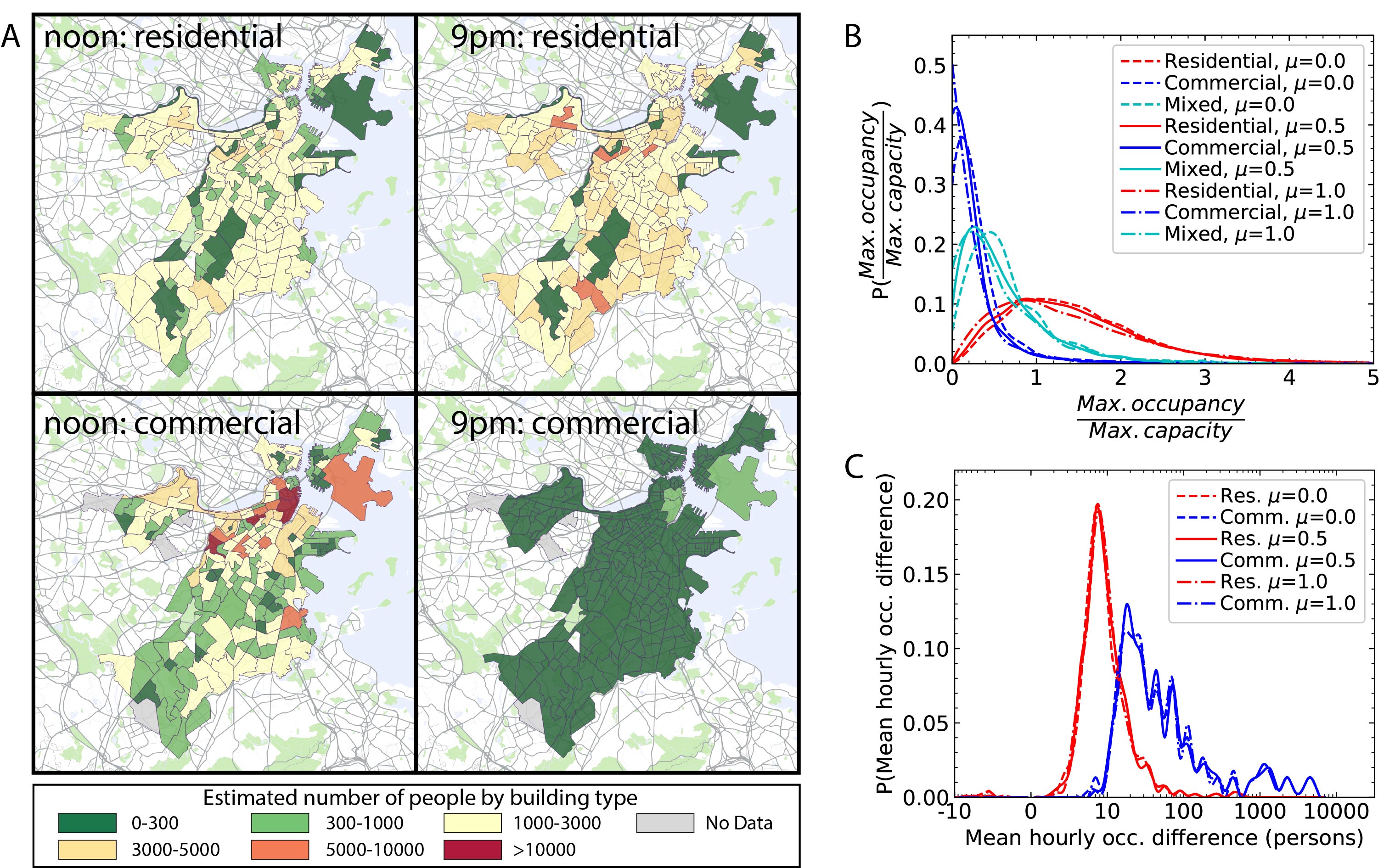Planning for sustainable cities by estimating building occupancy with mobile phones
September 20, 2019
In our new paper, Planning for sustainable cities by estimating building occupancy with mobile phones published in Nature Communications, we develop a novel methodology for estimating building occupancy at urban-scale using mobile phone data.
Energy use in buildings accounts for more than 40% of total energy consumption in the EU and US, with consumption particularly concentrated in the world's growing urban areas. Therefore, making buildings in cities more efficient could dramatically reduce our CO2 emissions. Since occupants are the primary drivers of energy use in most buildings, to identify the best efficiency measures for urban buildings necessitates an accurate picture of building occupancy which can be used in state-of-the-art building energy modelling tools, like the UMI tool developed by the SDL lab at MIT. The occupancy used in the models must capture how people move from building-to-building and identify highly-populated and sparsely populated areas at different times. Previous work has exploited various data sources such as indoor CO2 sensors, Bluetooth and WiFi connectivity and cameras to infer building occupancy. However, these data sources are not yet available at large enough scale to be used in urban-scale energy models.
One thing many of us always have on us though is our mobile phone. Every time we make a call our mobile phones communicate with nearby cell towers and by interpolating the signal between adjacent towers, an approximate location of the mobile device can found. The accuracy of this location estimate depends on the density of cell towers, with dense cell tower networks in urban areas allowing location estimates with resolution of a couple of hundred metres. Therefore, in our recent paper Planning for sustainable cities by estimating building occupancy with mobile phones, we develop a novel data-driven approach to estimating occupancy based on mobile phone data, information in digital maps and census data. By combining these data sources, we can create an empirically based population movement model, which simulates population movement at an urban-scale and subsequently probabilistically assigns people to buildings. Notably, our model agrees with state-of-the-art transportation models, census measures of population and traffic predictions.
To demonstrate our model’s significance for building energy consumption, we use the state-of-the-art UMI tool developed by the Sustainable Design Lab at MIT for a mixed-use neighbourhood of Boston, USA. By incorporating our occupancy model, we find typical occupancy rates which are 20-30% of current assumptions for commercial buildings and are highly variable according to neighbourhood for residential buildings. This discrepancy primarily arises due to the isolated treatment of buildings in current assumptions, whereas our models accounts for people travelling from building to building at different times.

Figure 1: a Estimated number of building occupants from mobile phone data model by building type for residential and commercial buildings. b Distributions of the ratio of maximum observed building occupancy to nominal building capacity for ~83,000 buildings in Boston. c Distribution of average hourly occupancy difference between reference building occupancy (based on DOE reference building data) and mobile-inferred occupancy for the 1,266 buildings in the energy model. Positive means the reference building based occupancy assumption is greater while negative implies the opposite. Maps created using Google Maps, 2019 Google
Our occupancy model leads to energy consumption estimates which differ by up to 15% for residential buildings and 20% for commercial buildings. We also highlight uncertainty in the energy predictions due to a range of occupant-behaviour scenarios. In turn, this emphasizes the need for new occupant-to-load models to be developed, which can be applied across the diverse set of urban building types. Finally, our occupancy estimates predict impacts of energy conservation measures (such as increased insulation or high-efficiency appliances) which differ significantly with predictions made using traditional occupancy assumptions. This outlines a significant risk that suboptimal efficiency measures may be mistakenly encouraged by energy policy if inaccurate occupancy assumptions are used. Therefore, our occupancy model is important as governments and regulatory bodies must identify the most cost-effective energy conservation measures for both new and existing buildings, which is particularly important given the limited budgets of many sustainability offices.
In future, this model could be refined and integrated with additional data sources improving accuracy and scope. Most powerfully, the model could be integrated with real-time occupancy sensing in a sample of representative buildings. This would facilitate more accurate forecasts of building energy load and integration with the smart grid, for example identifying the most suitable buildings for demand response.